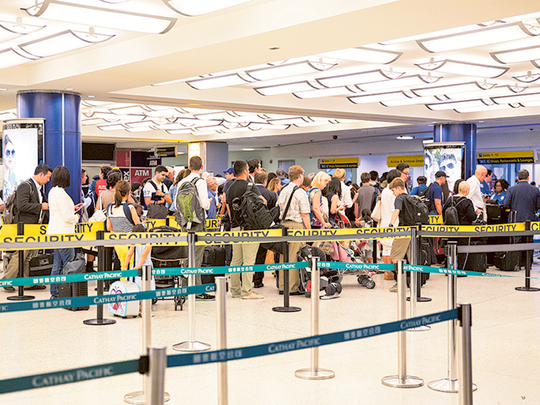
Airline executives hate few things more than supercheap ticket prices, which they often dub “junk fares” and “trash fares”. Yet the US airline industry has been awash in these deals for more than a year, as Spirit Airlines Inc and Frontier Airlines Inc expanded aggressively, and Southwest Airlines Co. began flying nationwide from Dallas.
Some examples: $41 from Dallas to New York City; $34 from Las Vegas to San Francisco; $40 from Nashville to Orlando.
The bargains aren’t pricing mistakes, nor have they been hard for consumers to find on off-peak travel days such as Tuesdays, Wednesdays, and Saturdays. The industry’s Big Three airlines, American Airlines Group Inc, Delta Air Lines Inc, and United Continental Holdings Inc, have matched such fares to varying degrees.
This spring, the Big Three decided cheap no longer paid. Instead, they began restricting the bargains: No longer are they allowing ticketing engines to piece together these nonrefundable fares — typically the least expensive — when a trip involves several cities. The multi-city pricing tweaks have whacked mostly business travellers, who often hit several destinations on their work circuits.
These types of trips, when bundled together, could cost hundreds of dollars more than they did before the airlines decided to drop the hammer. Airlines “are trying to divide the world between business and non-business flyers,” said George Ferguson, a Bloomberg Intelligence airline analyst. “The average Joe really won’t care if his firm loses an extra couple hundred bucks.”
For example, a May 9-13 trip on American from Los Angeles to San Francisco to Chicago and back to Los Angeles was $1,264.70, compared with $453 if all three flights were ticketed separately, according to FareCompare.com, a Dallas-based fare tracking firm. Of course, the expensive downside of trying to save money with separate tickets comes if you need to change your plans, which many business travellers often do: The Big Three assess a $200 change fee for each ticket.
These changes show the carriers’ effort to limit the reach of their lowest fares, which they’re using as a shield against further market-share losses to Spirit and Frontier. Spokesmen for American and United said travellers were assembling these bargain-basement fares for trips in ways the carriers had not intended.
American spokesman Joshua Freed said the pricing changes affect only “a numerically small number of travellers” given that most itineraries are simple round trips or one-way flights. “This is not your sort of average mom-and-pop round trip from Chicago to Orlando and back,” he said.
United retreated somewhat and altered pricing rules to allow for more of its fare classes to be used on multi-city trips. “We’ve heard from our customers,” United spokesman Jonathan Guerin said. “We’re definitely listening to them.”
Delta has declined to discuss the issue, including with a JPMorgan Chase & Co. analyst, Jamie Baker, who asked executives whether the changes might potentially boost passenger revenues. “High-quality industrial transports don’t duck and weave on this topic,” Baker said.
Beyond the ability to squeeze more dollars from corporate road warriors, the airline pricing changes also speak to the broader demise of fare rules in recent years, as the low-cost entrants disrupted traditional shibboleths: No longer is a Saturday-night stay mandated, a round trip is frequently more expensive than purchasing two one-ways, and a fare to fly tomorrow can be just as cheap as one bought three weeks before the travel.
The math of low fares is perhaps best illustrated at American, the world’s largest airline and the one most vocal about defending its market share against the upstarts.
Spirit now serves 25 destinations from Dallas-Fort Worth International, American’s largest hub, and Frontier has expanded to overlap 11 per cent of American’s domestic capacity, up from 1 per cent before American merged with US Airways. American Airlines President Scott Kirby, for example, has said on several occasions that 87 per cent of American’s customers have flown the airline only once in the past 12 months, a testament to travellers’ price sensitivity.
Spirit and Frontier have also led the Big Three to create new bare-bones fares modelled on Delta’s Basic Economy, which are priced lower but don’t allow for advance seat assignments, upgrades, or changes. Delta said that these fares generated $20 million in revenue in the first quarter and that they would expand to further markets.
American and United are expected to introduce their own similar fares later this year. While that seems to make sense, the Big Three’s decision on multi-city fares has some scratching their heads.
“The airlines just really screwed this whole thing up,” said Brett Snyder, a former airline pricing analyst who first wrote about the multi-city fare changes on March 31 on his blog. “They had a problem, and they just didn’t think it through on how to solve it.”












